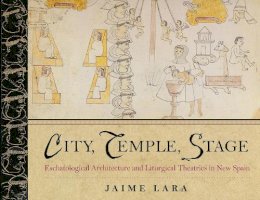
Stock image for illustration purposes only - book cover, edition or condition may vary.
City, Temple, Stage: Eschatalogical Architecture and Liturgical Theatrics in New Spain
Jaime Lara
€ 75.76
FREE Delivery in Ireland
Description for City, Temple, Stage: Eschatalogical Architecture and Liturgical Theatrics in New Spain
Hardcover. An interpretation of the art, architecture, and liturgy created for the conversion of Aztecs and other native peoples of central Mexico by European Franciscan missionaries in the mid-16th century. Num Pages: 408 pages, 239 colour images. BIC Classification: 1KLCM; 3JB; ACN; AM. Category: (P) Professional & Vocational; (UP) Postgraduate, Research & Scholarly; (UU) Undergraduate. Dimension: 279 x 254 x 30. Weight in Grams: 2118.
"This is a surprising detective story tracing the very complex paths and intersections of cultural, iconographical, and theological influences that formed the architecture and liturgical spaces of New Spain. I don't know of another scholar who has commanded this kind of knowledge about the Jewish, Christian, and Muslim streams of influence and interaction which appeared in the chapels, temples, and theatrical ritual spaces of Mexico." --David Carrasco, Harvard University
City, Temple, Stage is a new interpretation of the art, architecture, and liturgy created for the conversion of Aztecs and other native peoples of central Mexico by European Franciscan missionaries in ... Read more
Show LessProduct Details
Format
Hardback
Publication date
2004
Publisher
University of Notre Dame Press
Condition
New
Number of Pages
312
Place of Publication
Notre Dame IN, United States
ISBN
9780268033644
SKU
V9780268033644
Shipping Time
Usually ships in 7 to 11 working days
Ref
99-1
About Jaime Lara
Jaime Lara is associate professor of Christian art and architecture and chair of the Program in Religion and the Arts at Yale University Divinity School and Yale Institute of Sacred Music.
Reviews for City, Temple, Stage: Eschatalogical Architecture and Liturgical Theatrics in New Spain
“This is a brilliant, thorough, and innovative contribution to the studies of Spanish American colonial architecture, throughout which the author shows great erudition and command of visual and literary sources.” —Hispanic American Historical Review
